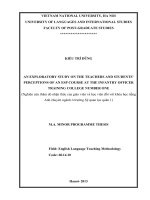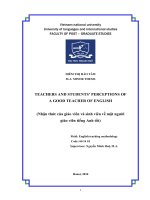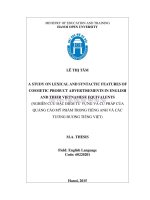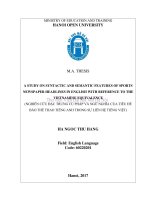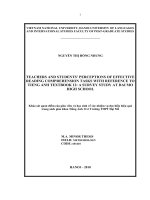A study on teachers and students perceptions of the use of pre learning activities in tieng anh 10 (global success) in phu my district
Bạn đang xem bản rút gọn của tài liệu. Xem và tải ngay bản đầy đủ của tài liệu tại đây (1.15 MB, 118 trang )
MINISTRY OF EDUCATION AND TRAINING
QUY NHON UNIVERSITY
NGUYEN HUYNH YEN ANH
A STUDY ON TEACHERS’ AND STUDENTS’ PERCEPTIONS OF
THE USE OF PRE-LISTENING ACTIVITIES IN TIENG ANH 10
(GLOBAL SUCCESS) IN PHU MY DISTRICT
Field: Theory and Methodology of English Language Teaching
Code: 8242170001
Supervisor : Dr. HA THANH HAI
BỘ GIÁO DỤC VÀ ĐÀO TẠO
TRƯỜNG ĐẠI HỌC QUY NHƠN
NGUYỄN HUỲNH YẾN ANH
NHẬN THỨC CỦA GIÁO VIÊN VÀ HỌC SINH VỀ VIỆC SỬ
DỤNG HOẠT ĐỘNG PRE-LISTENING TRONG GIẢNG DẠY
TIẾNG ANH 10 (GLOBAL SUCCESS) Ở CÁC TRƯỜNG THPT
TRÊN ĐỊA BÀN HUYỆN PHÙ MỸ
Ngành: Lý luận và phương pháp dạy học bộ môn Tiếng Anh
Mã số: 8242170001
Người hướng dẫn: TS. Hà Thanh Hải
i
DECLARATION OF AUTHORSHIP
I certify that the minor thesis entitled “ A study on the EFL teachers’
and students' perceptions of the use of pre-listening activities in Tieng Anh
10 (global success) in Phu My District” is the result of my own work. It was
conducted under the supervision of Dr. Ha Thanh Hai, a lecturer working at
Quy Nhon University.
I declare that the data included in this study are the product of my own
hard work and effort. More than what is noted in the references, I have not used
any additional materials. No other person’s work has been used without due
acknowledgement in the main text of the thesis. Additionally, neither a partial
nor a complete submission of this thesis has been made for any other degree or
diploma.
Binh Dinh, 2023
Nguyen Huynh Yen Anh
ii
ACKNOWLEDGMENTS
This thesis was not simply the result of my own efforts; It also benefitted
from the great help I got from institutions and people during the whole process,
to whom I would like to extend my deep gratitude.
First and foremost, I want to thank and appreciate my supervisor, Dr. Ha
Thanh Hai, from the bottom of my heart. I owe her for him clear direction,
considerate advice, loving support, and limitless patience. This study task could
not have been completed successfully if he had not taken the time to provide
the guidance.
Second, I want to express my gratitude for all the lectures I attended
during my M.A course for their profound and knowledgeable advice, which
unfailingly assisted me in overcoming all the challenges.
Thirdly, I want to express my sincere gratitude to the Department of Post-
graduate studies and the Department of Education at Quy Nhon University for
their administrative support.
Forthly, I extend my heartfelt gratitude to the English teachers at My
Tho, Nguyen Trung Truc, Phu My 1, and Phu My 2 high schools for their
invaluable assistance in responding to the interview inquiries, offering
constructive input for this research, and their openness in discussing pertinent
issues.
Fifthly, I express my gratitude to the students of various 10th-grade
classes, namely 10A1 and 10A3 at My Tho High School, 10A4 and 10A9 at
Phu My 2 High School, 10A2 and 10A4 at Nguyen Trung Truc High School,
and 10A1 and 10A5 at Phu My 1 High School, for their invaluable assistance
during my visits to collect data for the survey questionnaire. Their support was
iii
pivotal, and without it, the success of this study would not have been
achievable.
Lastly, I am grateful to have had the unwavering support and
companionship of my dear family and friends throughout this journey. Their
consistent encouragement during both the course and the research for this thesis
provided me with strength and a significant source of inspiration.
iv
ABSTRACT
This research focuses on teachers and students’ perceptions of the use
of pre-listening activities in Tieng Anh 10 (Global Success) in Phu My
District. With a keen interest in examining and analyzing the use of pre-
listening activities in enhancing listening skills among high school teachers in
Phu My, the author has undertaken a comprehensive review of relevant
literature to provide the theoretical foundation for this thesis. Consequently, the
researcher has established a solid conceptual framework to underpin and
substantiate the thesis. The study was conducted randomly, involving 16
English teachers and 326 tenth-grade students distributed across eight classes
in four high schools. The data analyzed in this study encompassed participants'
responses to questionnaires and interviews. The findings of this research shed
light on the preferences and feedback of both students and teachers concerning
the pre-listening activities in the new textbook, Tieng Anh 10 (Global
Success). Furthermore, the study offers a comparative analysis of teachers' and
students' perspectives regarding these pre-listening activities. Based on the
primary findings of this study, the author presents recommendations for the
implementation of pre-listening activities, outlines pedagogical implications
derived from the results, discusses the study's limitations, and suggests for
future research.
v
TABLE OF CONTENTS
DECLARATION OF AUTHORSHIP .......................................................................i
ACKNOWLEDGMENTS ..........................................................................................ii
ABSTRACT ............................................................................................................... iv
LIST OF TABLES..................................................................................................viii
LIST OF FIGURES .................................................................................................ix
1.1 Rationale ..........................................................................................................1
1.2. Aim and Objectives........................................................................................4
1.2.1. Research Aim............................................................................................4
1.2.2. Research Objectives..................................................................................4
1.3. Research Questions........................................................................................4
1.4. Scope of the Study..........................................................................................4
1.5. Significance of the Study ...............................................................................5
1.6. Organization of the Study .............................................................................5
CHAPTER 2. LITERATURE REVIEW...................................................................7
2.1. Definition of Perceptions ...............................................................................7
2.2. The Listening Skill .........................................................................................8
2.2.1. Definitions of Listening ...........................................................................8
2.2.2. Listening Processes ..................................................................................9
2.2.3. The Importance of the Listening Skill...................................................10
2.2.4. The Difficulties of Listening Skill .........................................................11
2.3. Listening Comprehension ...........................................................................11
2.3.1. Definitions ..............................................................................................11
2.3.2. How Listening Lessons Are Taught And Learned................................13
2.3.3. Barriers in Listening ..............................................................................14
2.4. Stages of Teaching Listening.......................................................................16
2.4.1. Pre-listening Stage .................................................................................16
2.4.2. While- listening Stage ............................................................................17
2.4.3. Post – listening Stage .............................................................................17
2.5. Pre-listening Activities.................................................................................18
2.5.1. What Is Pre-listening .............................................................................18
2.5.2. Definitions of Pre-listening Activities....................................................19
2.5.3. Advantages of Pre-listening Activities for Developing Listening
Abilities .............................................................................................................25
2.6. Previous Studies Related to Perceptions of Pre-listening Activities........25
2.7. Summary.......................................................................................................29
vi
CHAPTER 3. RESEARCH METHODOLOGY .....................................................30
3.1. Research Design ...........................................................................................30
3.2. Research Setting...........................................................................................31
3.3. Research Participants..................................................................................32
3.4. Research Instruments..................................................................................35
3.4.1. Questionnaires........................................................................................36
3.4.2. Interviews................................................................................................37
3.5. Data Collection Procedure ..........................................................................40
3.6. Procedure for Data Analysis .......................................................................41
3.7. Research Reliability and Validity...............................................................41
3.8. Legal And Ethical Considerations..............................................................41
3.9. Conclusion ....................................................................................................42
CHAPTER 4. FINDINGS AND DISCUSSION.....................................................43
4.1. Students’ Perception of Pre-listening Activities in the Textbook “English
10” (Global Success) ...........................................................................................43
4.1.1 Discussion of The Results Collected by Means of The Questionnaire .43
4.1.2 Discussion of the Results Collected by Means of the Interview ............59
4.2. Teachers’ Perceptions of Pre-listening Activities in the Textbook “Tieng
Anh 10” (Global Success) ...................................................................................61
4.2.1 Discussion of the Results Collected by Means of the Questionnaire ....61
4.2.2. Discussion of the Results Collected by Means of the Interview ...........73
4.3. Discussion of the Comparison between Teacher’s Perceptions and
Students’ Perceptions of Pre-listening Activities .............................................80
4.3.1. The Similarities ......................................................................................80
4.3.2. The Differences ......................................................................................82
CHAPTER 5. CONCLUSION AND IMPLICATIONS .........................................85
5.1. Conclusion ....................................................................................................85
5.2. Pedagogical Implications.............................................................................88
5.3 Limitations.....................................................................................................89
5.4. Recommendations and Suggestions for Further Research. .....................90
REFERENCES ........................................................................................................ 91
APPENCICES ........................................................................................................... I
vii
LIST OF ABBREVIATIONS
EFL : English as a Foreign Language
LC : Listening Comprehension
SLL : Second language learning
viii
LIST OF TABLES
Table 1.1. Pre-listening Activities (Ree, R. 2002)
Table 1. 2. Pre-listening Strategies (Devine, 1982)
Table 3.1. Summary of characteristics of the research participants (teachers)
Table 3.2. Summary of characteristics of the research participants (students)
Table 3.3. Research questions and instruments
Table 3.4. Back ground information of the interviewed teacher group
Table 3.5. Back ground information of the interviewed student group
Table 4.1: Students’ view about the necessity of carrying out pre-listening
activities.
Table 4.2: Students’ view about teacher’s frequency of using pre-listening
activities in class
Table 4.3: Students’ perceptions about advantages of pre-listening activities
Table 4.4: Teachers’ frequency of using pre—listening activities
ix
LIST OF FIGURES
Figure 1. Students’ opinion on the importance of listening skill
Figure 2. The views of students toward learning listening
Figure 3 : Students’ preferenece for teacher’s instruction
Figure 4: Students’ preference for method discussion
Figure 5: Students’ preference to pre-teaching vocabulary
Figure 6: Students’ expectation for providing the content of the listening
passage
Figure 7: Students’preference for kinds of questions
Figure 8: Students' perceptions on pre-listening activity in the text book
"Tieng Anh 10"
Figure 9: Students' suggestions for the updates to pre-listening activities in the
textbook "Tieng Anh 10"
Figure 10: Teachers’ perceptions towards listening skill
Figure 11: Teachers’ perceptions of pre-listening activities
Figure 12: Teachers’ perceptions of the most suitable pre-listening activities
for students
Figure 13: Teachers’ preference for helping students brainstorm.
Figure 14: Teachers’ preference for discussion method
Figure 15: Teachers’ preference for pre-teaching new words
Figure 16: Teachers’ preference of using techniques for introducing the
content of listening text
Figure 17: Teachers’s preference for using kinds of questions
x
Figure 18: Teachers’ perspectives of problem(s) when using pre-listening
activities
Figure 19: Teachers’ perceptions of the pre-listening activities in the text
book “ English 10” (Global Success)
Figure 20: Teachers’ suggestions for pre-listening activities in the textbook
1
CHAPTER 1. INTRODUCTION
The background information laid out in the introduction chapter is
helpful in understanding the topic of this study. Furthermore, it is established
with the thesis's framework, which consists of (1) a rationale, (2) aims and
objectives, (3) research questions, (4) the scope of study, (5) its significance,
and (6) organization.
1.1 Rationale
The ability to listen is one of the most crucial skills required to learn a
language. Listeners must have excellent listening skills to understand what is
being said, not just in the first language but also in the second. "We can expect
to listen twice as much as we speak, four times more than we read, and five
times more than we write." (Morley, J. 1991: 82). Students at Phu My Distric
struggle greatly to master listening skills, just like students around Viet Nam.
If they do not pay attention to what others are saying, they can rarely hear
spoken messages. Pre-listening activities are therefore essential for reducing
learners' apprehension before listening courses and for attracting their interest
in learning listening techniques. The effectiveness of pre-listening exercises
has been studied extensively and pre-listening strategies were the subject of a
study by Hong, L. T. T. (2006) to encourage students at Lomonosov upper-
secondary school to develop their listening skills. The study found that the pre-
listening strategies used by the teachers occasionally did not greatly motivate
the students. There were still discrepancies in teachers' and students'
preferences for pre-listening exercises. Huyen, N. D. conducted yet another
study on the pre-listening stage (2010), she looked into how pre-listening
exercises affected the listening skills of 10th graders at Nguyen Gia Thieu High
School in Hanoi. According to the study's findings, various pre-listening
exercises utilized by the teachers had a positive impact on the listening
2
comprehension of the pupils. Additionally, Ha, M. T. H. (2010) investigated
the impact of suitable pre-listening activities on the English listening
comprehension of 10th-form students. Pre-listening activities that encouraged
students to practice their listening abilities were greatly appreciated by both
teachers and students. These studies looked at the advantages of pre-listening
activities on students' ability to learn listening skills at various schools.
The researcher has come to the conclusion that each learner has a unique
attitude toward and method of approaching the acquisition of listening skills
based on observation and personal experience as an English teacher in a high
school. Many students prioritize learning reading and grammar despite the fact
that the new English textbooks are task-based and provide four practice skills.
They do not put much effort into mastering listening skills because they believe
they will not need them in national exams and because they find it difficult to
understand what is being said when listening in a one-way setting without
having a chance to interact with the speakers. The researcher has some
problems with the questions of which strategy addresses listening skill more
successfully and how pre-listening activities help students as they learn to
listen.
Vietnam is attempting to gradually implement educational reforms in
order to catch up with the goals of language instruction. For instance, teachers
put in time and effort to assist students enhance their communication skills in
English. It is a fact that, in accordance with Ministry of Education policy,
communicative approach is utilized to teach English. The government of
Vietnam's 2020 Project states that speaking and listening are becoming more
and more crucial components of learning English. Additionally, each high
school class focuses on teaching 4 communication skills, therefore there are
excellent teaching strategies for instructors to use while teaching listening
3
skills. The students listening abilities are still lacking for a variety of reasons,
though. First off, because most of the students at high schools in My Tho, Phu
My 2, Nguyen Trung Truc and Phu My 1 are from rural regions, they have less
experience with English than students who attend schools in major cities. The
absence of instruction and learning is another factor. Students' listening
comprehension and attitudes are strongly impacted by this. Additionally, the
class has between 40 and 50 students, when a class of 20 to 25 individuals is
optimum for learning a language. This may be even another barrier to students'
ability to develop their listening abilities. Because the students lack interest in
developing their listening skills, the teachers are less motivated to do so. As a
result, the study's goal is to investigate how pre-listening activities might help
students' listening comprehension.
Additionally, the Ministry of Education was implemented a new
program in 2022 called the 2018 General Education Program, which requires
all 10th grade students nationwide and in the Phu My district in particular to
use new textbooks. All of the high schools in this area use the Global Success
textbook published by Vietnam Education Publishing House Limited
Company for their English classes. The usefulness of pre-listening activities
has been the subject of numerous research studies, but the researcher is
interested in how teachers and students perceive pre-listening activities in the
context of the new 10th grade English textbook, about which no research has
been done.
For all of the reasons mentioned, the researcher would like to conduct
the thesis named “A study on teachers’ and students' perceptions of the use of
pre-listening activities in Tieng Anh 10 (global success) in Phu My District”. It
is also hoped that the study would provide instructors and students with some
4
recommendations for ways to enhance the teaching and learning of English,
particularly listening skills, at school.
1.2. Aim and Objectives
1.2.1. Research Aim
The objective of research is to investigate EFL teachers’ and students’
perceptions of the use of pre-listening activities in listening lessons in New
English textbook for grade 10.
1.2.2. Research Objectives
The study proposes the objectives as follows:
- To examine EFL students' perceptions of pre-listening activities
- To investigate EFL teachers’ perceptions of the use of pre-listening
activities.
- To find out the similarities and differences between the perceptions of
teachers and students of pre-listening activitives.
1.3. Research Questions
To achieve these objectives, three research questions are raised:
- What are high school students’ perceptions of pre-listening in learning
listening skills?
- What are EFL teachers’ perceptions of pre-listening in teaching listening
skills ?
- What are the similarities and differences between the teachers’ and
students’ perceptions of pre-listening activitives?
1.4. Scope of the Study
High school students currently study four skills—listening, speaking,
reading and writing, as well as vocabulary and grammar—but the majority of
students and teachers struggle to teach and learn listening skills. In order to
5
identify the benefits and offer solutions to aid students in developing listening
skills in the new 10th English textbook during the learning process, this study
focuses on the perspectives of students and teachers concerning the pre-
listening component.
1.5. Significance of the Study
This study aims to investigate how both students and educators at High
Schools in Phu My District feel about pre-listening activities. Following the
investigation, some recommendations will be made to assist teachers in
employing communicative teaching strategies to enhance students' learning
listening abilities. Since there are ways to help students learn listening and
assist teachers in choosing the appropriate pre-listening techniques in teaching,
this study will be an interesting reference tool that assists teachers in teaching
listening, especially pre-listening at school. In particular for those who are in
favor of improving their listening, it also helps students and teachers become
fully aware of their listening issues to which they may not have previously
given any attention.
1.6. Organization of the Study
The thesis consists of five chapters
Chapter 1: Introduction
The rationale, the aims, research questions, the scope, and the design of
the study are included in this chapter. The reasons for choosing the topic “A
study on teachers’ and students’ perceptions of the use of pre-listening
activities in Tieng Anh 10 (Global Success) in Phu My District”
Chapter 2: Literature Review
This chapter is divided to two subparts – theoretical background of
listening, pre- listening activities and previous studies. The first part provides
6
the knowlegde of theoretical framework used to conduct the research while the
second part is brief review of previous studies which are relevant to this
research.
Chapter 3: Methodology
This chapter presents research method, research procedures, the ways to
collect and analyze data. Research Methodology clearly demonstrates research
methods used it this study, data collection, data analysis, procedures, and
reliability and validity of the research. This chapter can help readers to
understand deeply the way the writer collects, analyses data as well as the steps
of conducting the research to fulfill the aims of the research with the assurance
of the objectiveness of the research.
Chapter 4: Data Analysis and Findings
The results from the data analysis are presented in this chapter, and the
discussions about the results are made. This chapter presents research findings
and discussions which provide the answers to the research questions. Based on
the answers to the research questions, this chapter investigates EFL teachers’
and students’ perceptions of the use of pre-listening activities in listening
lessons in New English textbook for grade 10 in Phu My District.
Chapter 5: Conclusion and Implications
This chapter gives the summary of the content of the study, draw
conclusions and implications. Recommendations for further research are also
demonstrated.
7
CHAPTER 2. LITERATURE REVIEW
The purpose of Chapter 2 is to review the theoretical background of the
study. This chapter will be divided into 5 main sections. It begins with
presenting(1) definitions of perceptions, then (2) the listening skill. The
following section deals with (3) listening comprehension, the concepts of (4)
stages of teaching listening and (5) Pre-listening activities are then presented.
In this chapter, the research also reviews (6) the previous studies related to
perceptions of pre-listening activities. Last but not least, (7) the summary is
also presented.
2.1. Definition of Perceptions
The definition of perception by McShane and Von Glinow (2010, p. 68)
is unmistakable: "Perception is the process of receiving information about and
making sense of the world around us." In other words, perception can be
thought of as the process through which our perception of the outside world is
shaped by our five senses. Positive and negative perceptions are the two
categories under which perception is categorized, according to Irwanto (2002,
as referenced in Fadillah, 2019). A favorable perception is one that
encompasses all of the knowledge and responses still in use. By interacting
with, accepting, and sustaining the perceived item, this process will be
repeated. Negative perception is the perception of all details and responses that
are opposed to the given item. As a result, a person's behavior will constantly
be influenced by both positive and negative views. Whether something is
perceived positively or negatively depends on how people interpret all of the
information they have about it. According to the current study, perception
refers to a person's conception of anything they learn in order to assess their
attitude toward using it and determine if they agree or disagree with the
approach or thing they learned. It implies that each student views their
8
education and their responses to it differently. According to Sidhu (2003),
students' perceptions are their points of view on anything that happens during
the learning process and offer suggestions or justifications for teachers or other
students to enhance their own learning.
According to the definitions provided above, it can be inferred that
perception occurs when students apply a particular meaning to the classroom
environment or their own classroom activities. As a result, in order to
comprehend another person's conduct, one must comprehend their
perspectives. In certain ways, a person's practice and perception are linked
(Bodenhausen & Hugenberg, 2009, p.14).
2.2. The Listening Skill
2.2.1. Definitions of Listening
In principle, listening differs from hearing. Hearing is limited to the
sounds you hear, whereas listening involves more. It is described as a process
that is both active and complex in nature. The mental activity of inferring
meaning from spoken input is called listening (Rost, M. 2002). According to
Helgesen, M. (2003), listening is the active, deliberate processing of
understanding what we hear. There is no doubt that the listener is engaged in
more than just interpreting what they hear. To determine the meaning or
message being conveyed by the speakers, he gathers information and compares
it to what he already knows. According to Underwood, M. (1989),
understanding spoken language requires a sophisticated process called
listening. She said that listening is the act of paying attention and attempting to
interpret what we hear.
Rost (2001) likewise sees listening as a complicated and active proces.
They contend that listening comprehension, as a goal-oriented activity, entails
both bottom-up and top-down processing that is supposed to occur at different
